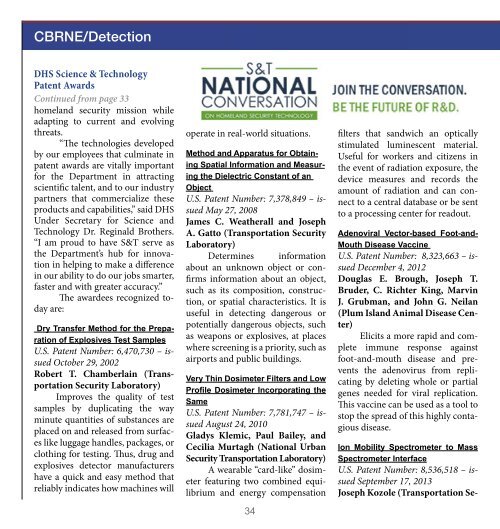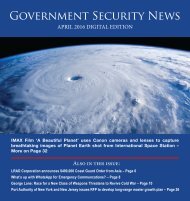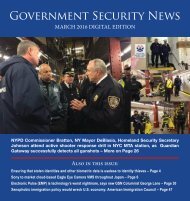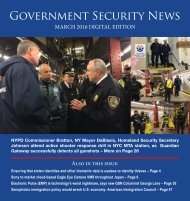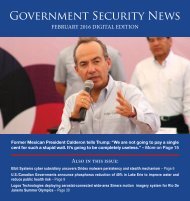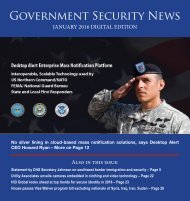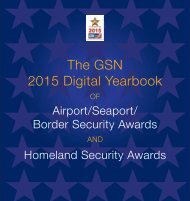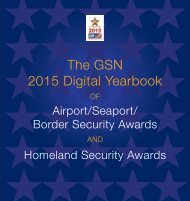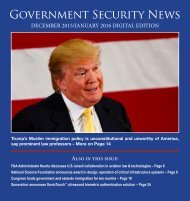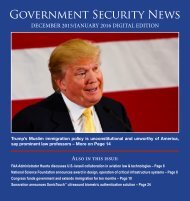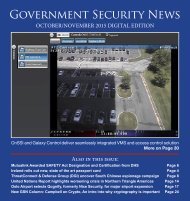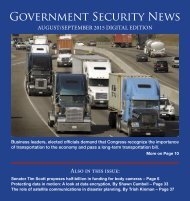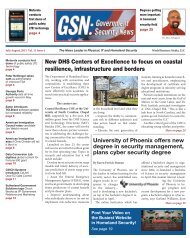2015 June/July Digital Edition
You also want an ePaper? Increase the reach of your titles
YUMPU automatically turns print PDFs into web optimized ePapers that Google loves.
CBRNE/Detection<br />
DHS Science & Technology<br />
Patent Awards<br />
Continued from page 33<br />
homeland security mission while<br />
adapting to current and evolving<br />
threats.<br />
“The technologies developed<br />
by our employees that culminate in<br />
patent awards are vitally important<br />
for the Department in attracting<br />
scientific talent, and to our industry<br />
partners that commercialize these<br />
products and capabilities,” said DHS<br />
Under Secretary for Science and<br />
technology Dr. Reginald Brothers.<br />
“i am proud to have S&t serve as<br />
the Department’s hub for innovation<br />
in helping to make a difference<br />
in our ability to do our jobs smarter,<br />
faster and with greater accuracy.”<br />
The awardees recognized today<br />
are:<br />
Dry Transfer Method for the Preparation<br />
of Explosives Test Samples<br />
U.S. Patent Number: 6,470,730 – issued<br />
October 29, 2002<br />
Robert T. Chamberlain (Transportation<br />
Security Laboratory)<br />
improves the quality of test<br />
samples by duplicating the way<br />
minute quantities of substances are<br />
placed on and released from surfaces<br />
like luggage handles, packages, or<br />
clothing for testing. Thus, drug and<br />
explosives detector manufacturers<br />
have a quick and easy method that<br />
reliably indicates how machines will<br />
operate in real-world situations.<br />
Method and Apparatus for Obtaining<br />
Spatial Information and Measuring<br />
the Dielectric Constant of an<br />
Object<br />
U.S. Patent Number: 7,378,849 – issued<br />
May 27, 2008<br />
James C. Weatherall and Joseph<br />
A. Gatto (Transportation Security<br />
Laboratory)<br />
Determines information<br />
about an unknown object or confirms<br />
information about an object,<br />
such as its composition, construction,<br />
or spatial characteristics. it is<br />
useful in detecting dangerous or<br />
potentially dangerous objects, such<br />
as weapons or explosives, at places<br />
where screening is a priority, such as<br />
airports and public buildings.<br />
Very Thin Dosimeter Filters and Low<br />
Profile Dosimeter Incorporating the<br />
Same<br />
U.S. Patent Number: 7,781,747 – issued<br />
August 24, 2010<br />
Gladys Klemic, Paul Bailey, and<br />
Cecilia Murtagh (National Urban<br />
Security Transportation Laboratory)<br />
a wearable “card-like” dosimeter<br />
featuring two combined equilibrium<br />
and energy compensation<br />
filters that sandwich an optically<br />
stimulated luminescent material.<br />
Useful for workers and citizens in<br />
the event of radiation exposure, the<br />
device measures and records the<br />
amount of radiation and can connect<br />
to a central database or be sent<br />
to a processing center for readout.<br />
Adenoviral Vector-based Foot-and-<br />
Mouth Disease Vaccine<br />
U.S. Patent Number: 8,323,663 – issued<br />
December 4, 2012<br />
Douglas E. Brough, Joseph T.<br />
Bruder, C. Richter King, Marvin<br />
J. Grubman, and John G. Neilan<br />
(Plum Island Animal Disease Center)<br />
Elicits a more rapid and complete<br />
immune response against<br />
foot-and-mouth disease and prevents<br />
the adenovirus from replicating<br />
by deleting whole or partial<br />
genes needed for viral replication.<br />
This vaccine can be used as a tool to<br />
stop the spread of this highly contagious<br />
disease.<br />
curity Laboratory)<br />
Uses collisional focusing to<br />
transfer ion beams of trace explosives<br />
between the mass spectrometer<br />
and the ion mobility spectrometer<br />
without distorting the beams.<br />
Explosive trace detector manufacturers<br />
can use this method and apparatus<br />
to fine-tune system performance<br />
by focusing on the precise<br />
chemical signatures unique to each<br />
kind of explosive.<br />
Inert and Non-toxic Explosive Simulants<br />
and Method of Production<br />
U.S. Patent Number: 8,563,316 – issued<br />
October 22, 2013<br />
Ronald A. Krauss, Stephen F.<br />
Duffy, and Stephen J. Goettler III<br />
(Transportation Security Laboratory)<br />
imitates characteristics of<br />
known explosives at the microscopic<br />
and macroscopic levels. Developers<br />
and manufacturers can use this<br />
method to safely verify the detection<br />
capabilities of X-ray-based explosives<br />
detection systems and to<br />
ensure proper calibration of screening<br />
systems, such as those used to<br />
screen airline passenger luggage.<br />
High-volume Sampling Front-end<br />
Collection Device<br />
U.S. Patent Number: 8,578,796 – issued<br />
November 12, 2013<br />
Inho Cho (Transportation Security<br />
Laboratory)<br />
a portable, pocket-sized<br />
front-end device that can brush off<br />
particles from a surface or collect<br />
a large volume of air, as in a cargo<br />
container, capturing threat particles<br />
with a specialized system of filters.<br />
The hand-held nature of this device<br />
allows users to quickly collect<br />
samples, and the device can attach<br />
to analytical screening systems to<br />
identify threat particles.<br />
Quick Release Flare Tube Adapter<br />
U.S. Patent Number: 8,770,083 – issued<br />
<strong>July</strong> 8, 2014<br />
Charles A. Hatfield, Thomas Morrow,<br />
Alexander Brown, Trent Meyers,<br />
and Katie Spira (U.S. Coast<br />
Guard Academy)<br />
an illumination flare mounting<br />
arrangement for use in an aircraft.<br />
Flares are essential in nighttime,<br />
over-water search and rescue;<br />
reconnaissance; and law enforcement<br />
missions when visibility is<br />
vital. Police, military, and paramilitary<br />
organization aircrews can<br />
quickly install or remove this adapter<br />
on a variety of aircraft without<br />
tools or special equipment.<br />
Method and Device for Detecting<br />
Moving Radiation Sources<br />
U.S. Patent Number: 8,916,832 – issued<br />
December 23, 2014<br />
Thomas E. Albert (Domestic Nuclear<br />
Detection Office)<br />
Detects radioactive sources<br />
34 35<br />
Ion Mobility Spectrometer to Mass<br />
Spectrometer Interface<br />
U.S. Patent Number: 8,536,518 – issued<br />
September 17, 2013<br />
Joseph Kozole (Transportation Sethat<br />
are in motion and facilitates the<br />
rapid and accurate identification of<br />
the source of radioactive material.<br />
This invention is intended for use at<br />
seaports and border crossings that<br />
screen cargo containers, vehicles,<br />
or pedestrians for radiological or<br />
nuclear materials and in mobile radiation<br />
detectors deployed in search<br />
operations.<br />
Buoy Split Key Removal Device<br />
U.S. Patent Number: 8,914,962 – issued<br />
December 23, 2014<br />
Jessica Rozzi-Ochs, Bret Jacobson,<br />
Khiem Nagy, Erin Nolan, Evan<br />
Rice, and Sarah Troch (U.S. Coast<br />
Guard Academy)<br />
Utilizing a power screw that<br />
applies steady and controllable compression<br />
to the split key, the device<br />
allows USCg buoy tender crewmembers<br />
to quickly remove split<br />
keys in a safe and efficient manner.<br />
The split key is a butterflied key that<br />
holds a pin in place, connecting a<br />
chain between the buoy and a concrete<br />
block on the floor of a body of<br />
water.<br />
Nuclear Magnetic Resonance Scanning<br />
of Metal Containers Using Medium-field<br />
Technology<br />
U.S. Patent Number: 8,912,795 – issued<br />
December 16, 2014<br />
Joseph S. Broz and Stephen W.<br />
Surko (Contract Laboratory)<br />
More on page 46


